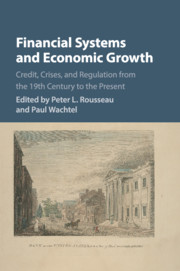29 results
Julian Hoppit, Duncan Needham, and Adrian Leonard, eds. Money and Markets: Essays in Honour of Martin Daunton. Woodbridge: Boydell Press, 2019. Pp. 294. $25.95 (paper).
-
- Journal:
- Journal of British Studies / Volume 60 / Issue 4 / October 2021
- Published online by Cambridge University Press:
- 06 October 2021, pp. 996-997
- Print publication:
- October 2021
-
- Article
- Export citation
Milton Friedman and Economic Debate in the United States, 1932–1972. 2 Vols. By Edward Nelson. Chicago: University of Chicago Press, 2020. Vol. 1: xviii + 737 pp. Illustrations, tables, bibliography, index. Cloth $50.00. ISBN: 978-0-226-68377-5. Vol. 2: xiv + 587 pp. Illustrations, tables, bibliography, index. Cloth $50.00. ISBN: 978-0-226-68489-5.
-
- Journal:
- Business History Review / Volume 95 / Issue 2 / Summer 2021
- Published online by Cambridge University Press:
- 28 July 2021, pp. 341-343
- Print publication:
- Summer 2021
-
- Article
- Export citation
2 - Episodes of Financial Deepening: Credit Booms or Growth Generators?
-
-
- Book:
- Financial Systems and Economic Growth
- Published online:
- 06 October 2017
- Print publication:
- 01 September 2017, pp 52-75
-
- Chapter
- Export citation
Copyright page
-
- Book:
- Financial Systems and Economic Growth
- Published online:
- 06 October 2017
- Print publication:
- 01 September 2017, pp vi-vi
-
- Chapter
- Export citation
Dedication
-
- Book:
- Financial Systems and Economic Growth
- Published online:
- 06 October 2017
- Print publication:
- 01 September 2017, pp vii-viii
-
- Chapter
- Export citation
Index
-
- Book:
- Financial Systems and Economic Growth
- Published online:
- 06 October 2017
- Print publication:
- 01 September 2017, pp 283-292
-
- Chapter
- Export citation
Introduction
-
-
- Book:
- Financial Systems and Economic Growth
- Published online:
- 06 October 2017
- Print publication:
- 01 September 2017, pp 1-13
-
- Chapter
- Export citation
Discussants at the Conference
-
- Book:
- Financial Systems and Economic Growth
- Published online:
- 06 October 2017
- Print publication:
- 01 September 2017, pp xvi-xvi
-
- Chapter
- Export citation
Contents
-
- Book:
- Financial Systems and Economic Growth
- Published online:
- 06 October 2017
- Print publication:
- 01 September 2017, pp ix-x
-
- Chapter
- Export citation
Contributors
-
- Book:
- Financial Systems and Economic Growth
- Published online:
- 06 October 2017
- Print publication:
- 01 September 2017, pp xi-xv
-
- Chapter
- Export citation

Financial Systems and Economic Growth
- Credit, Crises, and Regulation from the 19th Century to the Present
-
- Published online:
- 06 October 2017
- Print publication:
- 01 September 2017
The Half Has Never Been Told: Slavery and the Making of American Capitalism. By Edward E. Baptist. New York: Basic Books, 2014. Pp. xxvii, 498. $35.00, cloth.
-
- Journal:
- The Journal of Economic History / Volume 75 / Issue 3 / September 2015
- Published online by Cambridge University Press:
- 27 August 2015, pp. 919-931
- Print publication:
- September 2015
-
- Article
- Export citation
Director Histories and the Pattern of Acquisitions
-
- Journal:
- Journal of Financial and Quantitative Analysis / Volume 50 / Issue 4 / August 2015
- Published online by Cambridge University Press:
- 26 October 2015, pp. 671-698
- Print publication:
- August 2015
-
- Article
- Export citation
7 - Politics on the Road to the U.S. Monetary Union
-
-
- Book:
- Current Federal Reserve Policy Under the Lens of Economic History
- Published online:
- 05 March 2015
- Print publication:
- 05 March 2015, pp 151-173
-
- Chapter
- Export citation
American Banking and the Transportation Revolution before the Civil War
-
- Journal:
- The Journal of Economic History / Volume 74 / Issue 4 / December 2014
- Published online by Cambridge University Press:
- 27 November 2014, pp. 943-986
- Print publication:
- December 2014
-
- Article
- Export citation
The Market for Bank Stocks and the Rise of Deposit Banking in New York City, 1866–1897
-
- Journal:
- The Journal of Economic History / Volume 71 / Issue 4 / December 2011
- Published online by Cambridge University Press:
- 14 November 2011, pp. 976-1005
- Print publication:
- December 2011
-
- Article
- Export citation
The Philadelphia Stock Exchange and the City It Made. By Domenic Vitiellowith George E. Thomas. Philadelphia: University of Pennsylvania Press, 2010. Pp. xvi, 253. $45.00, cloth.
-
- Journal:
- The Journal of Economic History / Volume 71 / Issue 3 / 13 September 2011
- Published online by Cambridge University Press:
- 13 September 2011, pp. 815-816
- Print publication:
- 13 September 2011
-
- Article
- Export citation
Contributors
-
-
- Book:
- The Impact of Early Life Trauma on Health and Disease
- Published online:
- 03 May 2011
- Print publication:
- 05 August 2010, pp vii-xii
-
- Chapter
- Export citation
Commentary
-
-
- Book:
- Monetary Policy in Low-Inflation Economies
- Published online:
- 26 January 2010
- Print publication:
- 31 July 2009, pp 302-314
-
- Chapter
- Export citation
One Nation Under Debt: Hamilton, Jefferson, and the History of What We Owe. By Robert E. Wright. New York: McGraw Hill, 2008. Pp. vii, 419. $28, cloth.
-
- Journal:
- The Journal of Economic History / Volume 69 / Issue 2 / June 2009
- Published online by Cambridge University Press:
- 01 June 2009, pp. 606-608
- Print publication:
- June 2009
-
- Article
- Export citation



